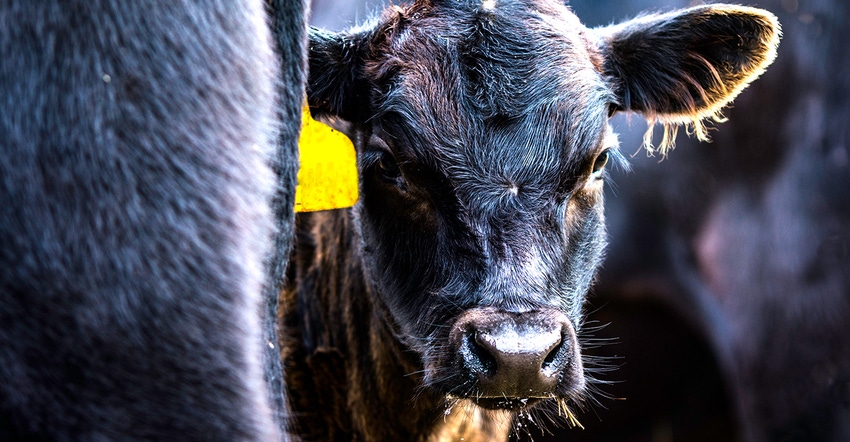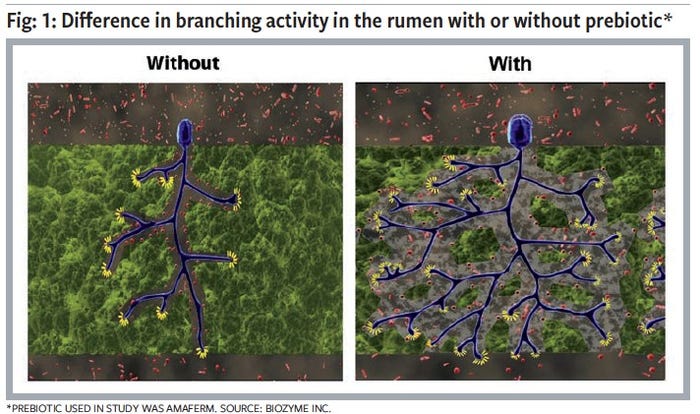October 29, 2018

Sponsored Content
“Nutrition is the next step in the evolution of health,” says Jason Barber, purebred division manager with Superior Livestock, talking about value-added programs. “Shots can be given, but this side (nutrition) needs more attention.”
With consumer backlash against antibiotic use, other means of improving health and performance are receiving more discussion. One such way is to use additives like probiotics and prebiotics.
Superior is incentivizing the use of prebiotics with one of its value-added programs, Barber says. The products are especially useful in getting weaned calves off to a good start.
The main difference between a prebiotic and a probiotic is that a prebiotic is not a living microorganism; a probiotic is. A prebiotic is actually food for living microorganisms. A probiotic adds more “good” bacteria to the gut, while a prebiotic works to help existing microbes multiply.
Probiotics
A probiotic contains specific strains of bacteria, but the handling of these bacteria is incredibly important, says Angel Aguilar, technical service manager for Lallemand Animal Nutrition.
“Not every probiotic is worth the investment,” says Aguilar. “In animals, there are many dynamic and robust bacterial communities that are essential for productivity and well-being. Influencing these communities in a positive way can result in better overall health and productivity. Positive responses we’ve seen in research trials can even lead to reduced treatment costs. Yet, you can’t add just any probiotic to a ration and expect amazing results.”
There are thousands of yeast and bacteria strains, and each can have a different effect — or sometimes no effect at all, he says.
Harsh environments and poor handling can harm these beneficial organisms, Aguilar says. Each strain of yeast or bacteria has its own specific growing, handling and storage preferences. This is why it is so important for producers to buy probiotics from a reputable manufacturer to ensure that their probiotic is pure, consistently produced and packaged strategically to maximize product quality and performance all the way to the feedbunk.
“It is well-recognized that probiotic microorganisms must be alive, or viable, to have an effect on the microflora of the animal’s digestive system,” he says. “In fact, many governmental agencies will only authorize a claim on performance — such as improved milk production or feed efficiency— when the probiotic microorganism is viable.”
Additionally, these products must be specifically selected for the intended outcome. Certain probiotics stimulate the animal’s bacterial population in a specific way. For example, one strain of probiotic may stimulate the immune function, while another may improve feed efficiency.
Saccharomyces cerevisiae has been used for centuries in baking, brewing, human and livestock nutrition, and even in biofuel production. There are thousands of species of S. cerevisiae, and not all perform in the same way, he adds.
“Saccharomyces cerevisiae boulardii CNCM I-1079, for example, has been proven to be more effective at positively impacting cattle and hog health status, especially during times of stress,” Aguilar says. “Another strain of S. cerevisiae — CNCM I-1077 — has been proven to optimize rumen function by positively increasing rumen pH and fiber digestibility in cattle.”
Other bacterial probiotics have been shown to have specific effects in livestock. A certain strain of Lactobacillus acidophilus — strain BT-1386 — has been documented to reduce the prevalence of E. coli O157:H7 in feedlot cattle.
Finally, producers must add probiotics on a daily basis to maintain levels high enough to see benefits in the animal. Live probiotics generally do not reproduce or colonize in the animal’s digestive system, so daily consumption of a probiotic ensures the right amount of microorganisms are available to do the intended job.

Prebiotics
A prebiotic is a fermentable ingredient that promotes the growth and activity of the microbes that contribute to the well-being of the animal, explains Ignacio Ipharraguerre, director of research and innovation for BioZyme Inc. Simply put, it does this by supplying nutrients to the beneficial microbes that are present in the gut of the animals.
He explains that the fungus used in his company’s proprietary product Amaferm is Aspergillus oryzae (AO). It is a multicellular, filamentous fungi that was domesticated 2,000 years ago in Asia. It secretes large quantities of enzymes in solid-state fermentation.
The fungus itself is not rare, but the fermenting process is unique. The AO strain is flexible, he says, and can adapt to different environments. The temperature, amount of agitation and aeration contribute to the final product.

In a way, it’s similar to wine, in which different wineries can use the same grape, but their own recipes create a different final bottled product.
Ipharraguerre says this recipe creates a prebiotic designed to enhance digestibility by amplifying the nutrient supply within. It promotes intake, increases feed digestibility, and maximizes nutrient absorption.
How do tiny fungi do this?
Think back to biology classes. The plant cell wall consists of cellulose, hemicelluloses and lignin. The fungi present in the rumen produce microbial enzymes. These enzymes provide a way to break the hemicellulose-lignin bond, and thus they pave the way for the animal to absorb the plant’s nutrients.
The fermentation recipe of this prebiotic increases the fungal branching frequency within the rumen (see Fig. 1). These little branches help break down the plant material in the rumen much more quickly, which allows the secretion of more microbial enzymes that let metabolizing bacteria attach and double.
Nutritionists often joke that when cattlemen feed a ruminant, they are really feeding the bacteria in the rumen. Ipharraguerre says the bacteria load in the rumen actually increases when fed the prebiotic.
“What you feed cattle determines the rumen’s microbiota,” Ipharraguerre says. “Those microbiota adapt to the food present.”
Simply put, the more fungal branches there are, the more food gets broken down and the more nutrients are absorbed. That lets the animal use more of what it has already eaten.
If the food in the rumen gets broken down more quickly because of these fungi and bacteria, there is now room in the rumen for the animal to eat more and gain more quickly.
Performance benefits
Past the biology lesson, what are the tangible benefits?
Ipharraguerre shares research showing that including prebiotics in rations can improve return on investment through better feed efficiency, increased production or more robust immune responses. In six different studies, the use of a prebiotic increased nutrient intake by an average of 1 pound (lb.), or an increase of 3%.
Research on his company’s prebiotic showed improvement in neutral detergent fiber (NDF) digestibility across a variety of forages, including brome hay, alfalfa hay, total mixed ration, haylage, corn silage, straw and fescue, he says. The average increase in NDF digestibility from all 10 of these published studies was 17.3%.
On average, research has shown that it resulted in 3% more intake, 10% more crude protein digestibility, 17% more forage fiber digestibility, 16% more volatile fatty acids, 31% more microbial protein and 30% more nutrient absorption.
Calves given the prebiotic had a 0.25 lb. greater average daily gain (ADG). Ipharraguerre notes the prebiotic’s greatest effect is during the weaning and starting period.
Additional profit opportunities
In addition to gaining performance and starting weaned calves on the right foot, cattlemen can gain additional marketing leverage from using additives. Superior Livestock has a new value-added program for nutritional preconditioning.
Says Barber, “Traditionally, when ranchers think of adding value, it is derived from a quality health program dependent upon vaccinations, but together Superior and BioZyme are putting a new twist on creating premiums for healthier cattle through a mineral supplement nutrition program.”
Barber says the program targets stockers and feeders and recognizes calves that have been fed a Vitaferm® Gain Smart® mineral for a minimum of 45 days prior to sale and through delivery. Cattle identified for the program on the consignment contracts will receive the program logo on the auction sale books and online.
Story & photo by Kasey Brown, associate editor of Angus Beef Bulletin
About the Author(s)
You May Also Like




